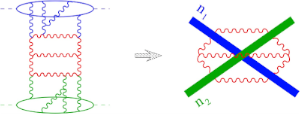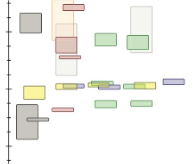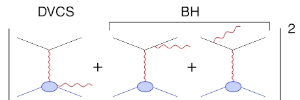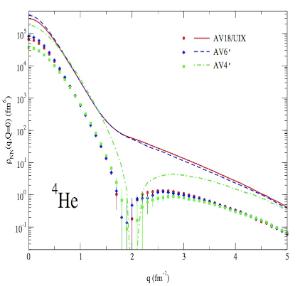The ODU theory group performs research across a broad range of topics in hadronic and nuclear physics, from the keV energy scale in light nuclei to the scattering of nucleons at multi-GeV energies. Their work is of relevance to experiments across the globe, with particular emphasis on experiments performed at the nearby Jefferson Lab, where all group members are also staff scientists.
Quantum Chromodynamics at High-Energy
At high energies, the theory of QCD can be described perturbatively in terms of explicit interactions between quarks and gluons. Within this framework, recent and current topics of study include calculations of Deeply Virtual Compton Scattering(DVCS) at small x, scattering of color dipoles corresponding to fast moving quark-antiquark pairs of finite size and construction of an effective theory, valid at high energy, that recasts the gluonic dynamics of QCD in terms of Wilson lines of the gauge field.
Hadron Spectroscopy & Lattice QCD
Interests include the study of the spectrum and decays of hadronic resonances. This includes the extraction of resonance properties from experimental data by the building of models describing the hadronic reaction involved. The nature of these states is investigated using models at the quark level and, where possible, by a controlled approximation to QCD named Lattice QCD. Lattice QCD considers the quark and gluon fields to live on a four-dimensional grid of spacetime points, rendering the number of degrees-of-freedom finite and casting it into a form suitable for numerical computation. Large-scale computing resources are utilised to compute observable quantities. Older work includes the spectrum of the charmonium mesons as well as their radiative and two-photon decays. Recently new methods have allowed the exploration of the light meson spectrum and the investigation of hybrid mesons in which the gluonic field plays a fundamental role.
At intermediate energies, hadronic observables can often be separated into pieces sensitive to short distances and calculable in perturbative QCD and other pieces, sensitive to longer distances, that are essentially non-perturbative. An example of these non-perturbative objects are the Generalised Parton Distributions(GPDs) that describe the quark-gluon substructure of the nucleon. These are an ongoing research interest that is being modeled in a number of ways, including their estimation in the QCD Sum-Rule approach which utilises the condensates of quarks and gluons that fill the vacuum of QCD. Defining the connection between GPDs and experimental observables in processes like DVCS and wide-angle Compton scattering remains an active area of research.
Studies of Light Nuclei from keV to GeV Energies
Nuclear structure can be studied precisely using the response to probes electromagnetic and weak in nature. Studies of few-body systems are aimed at producing a quantitative understanding of the structure and dynamics of light nuclei with A<8 based on realistic interaction models, and electroweak current operators constructed consistently with these interactions. Exact Monte Carlo methods suitable for the nuclear many-body problem are being developed and applied to investigate a wide variety of properties depending on the bound and continuum spectra of the nuclei, such as for example, very low-energy electroweak capture reactions, or the response to lepton and hadronic probes in the quasi-elastic regime.
Relativistic Dynamics in Hadrons and Nuclei
At the energy and momentum transfers typical of experiments at Jefferson Lab, it is necessary to include the effects of special relativity in any calculation of electron scattering reaction from nuclei. It has also been shown that for surprising large energy and momentum transfers it is still appropriate to describe nuclei as consisting of nucleons interacting through the exchange of mesons. Models of nuclei under these conditions can be constructed using techniques related to the relativistic Bethe-Salpeter equation for two- and many-nucleon systems. Similar techniques have also been applied to relativistic constituent quark models of mesons and baryons.





